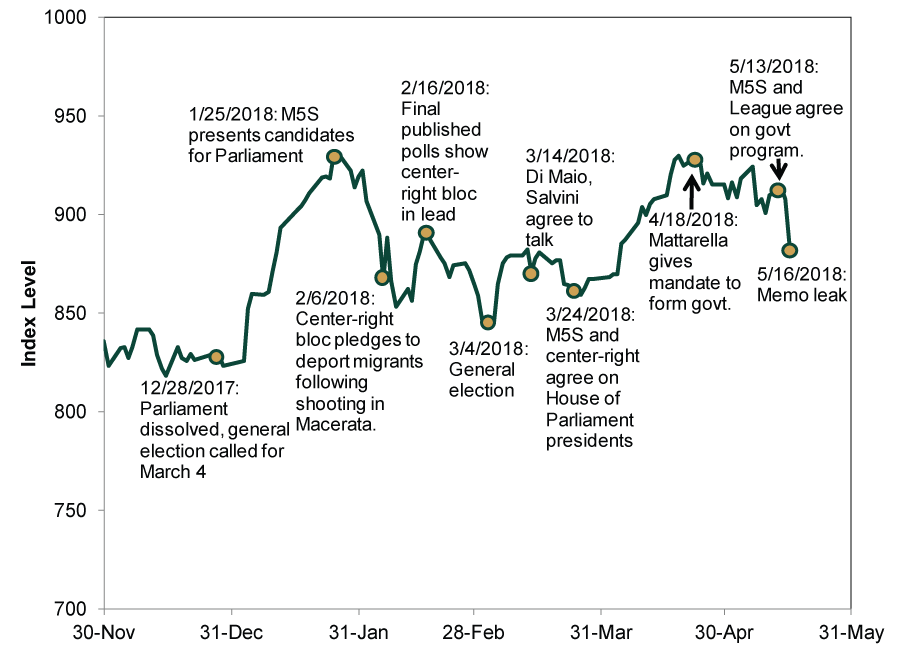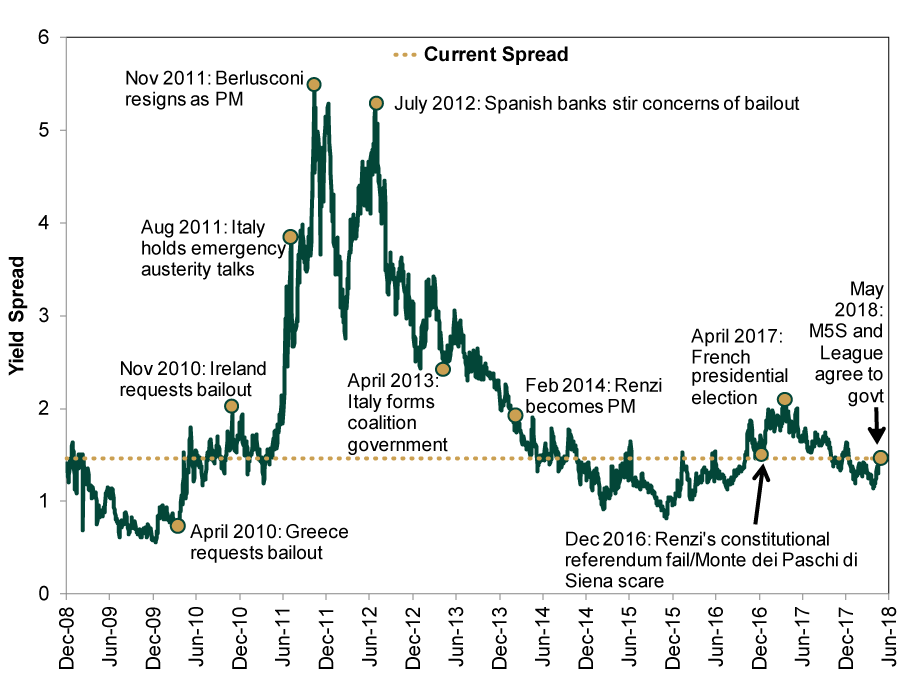Personal Wealth Management / Politics
Italy’s Populist Opera Probably Has a Familiar Ending
Whether or not scary-sounding items are part of a final coalition deal, gridlock likely prevents radical change—as it has in Italy for years.
After more than two months, the antiestablishment Five Star Movement (M5S) and the far-right League look close to forming a populist ruling coalition in Italy, stirring concerns of future instability and uncertainty in the eurozone’s third-largest economy—particularly after a leaked draft of their proposed agenda that made its way to the Internet on Wednesday included items like, ask the ECB to cancel €250 billion in debt. Italian stocks were properly spooked, falling 3.3% on the day.[i] Whether or not party leaders’ claims that this memo was “old” and doesn’t resemble their current agenda turn out to be true, we think a radical, negative shift in policy is unlikely. Gridlock probably prevents a M5S-League coalition from passing the sort of major, sweeping changes stocks typically dislike.
For the Reader’s Digest version of recent Italian politics, President Sergio Mattarella dissolved Parliament in late December 2017 and called a general election for March 4. M5S, which led opinion polls, won the most votes of any single party but fell far short of a majority. A center-right coalition won the most seats, but contrary to expectations, Matteo Salvini’s League did better than coalition leader Silvio Berlusconi’s Forza Italia—putting Salvini in charge of his coalition’s efforts to form a government. Since then, he and M5S leader Luigi Di Maio have alternately tried to come to terms and argued over which party should lead any potential alliance.
After several rounds of failed talks, Di Maio and Salvini called for new elections last week—a scenario Mattarella tried shooting down. But then M5S and the League announced progress on a coalition deal after Berlusconi agreed not to be involved in the government—a major sticking point for M5S. The two parties talked through the weekend and met with Mattarella on Monday to provide an update, saying they needed more time to hammer home the final details but were getting close.
This brings us to Wednesday’s leaked memo—alleged evidence M5S and the League envision a new EU relationship—which amplified extant worries over a populist government bringing chaos. However, this seems a tad premature. Both parties, which denounced the memo as out-of-date, remain in deliberation mode. Watch what politicians do, not what they say, but party leaders claim the memo was never an official policy draft and they never seriously considered asking for a debt haircut. The other item raising eyebrows, asking eurozone officials to create procedures for member-states to leave the eurozone, is an endgame no one country can will into existence. Meanwhile, the few broad highlights from the M5S-League coalition’s governing program that have come out are less radical. One big proposal is to cut and simplify taxes via a flat-rate income tax of 15%—in the old days, people called this sort of thing “pro-market.” Other aims span the political spectrum, from implementing a universal wage for the poor and reducing the retirement age to imposing stricter immigration rules. There are also rumblings about studying a parallel currency, building off some theoretical work done by Yanis Varoufakis when he was Greece’s finance minister—unorthodox, but far from a one-way ticket to Italexit.
Euro-related jitters aside, most fears dwell on the potential for M5S and the League to crank up public spending while cutting taxes, setting up a potentially troublesome debt situation. Yet until Wednesday’s post-memo volatility, the market reaction had been rather muted. In our view, the market, which prices in all widely known information better than any expert, isn’t missing anything. Despite some dips, Italian stocks are up 5.3% year-to-date.[ii] (Exhibit 1)
Exhibit 1: Politics Haven’t Freaked Out Italian Stocks

Source: FactSet, as of 5/17/2018. MSCI Italy with net dividends in USD dollars, 11/30/2017 – 5/16/2018.
The spread between Italy’s 10-year yield and the 10-year German bund yield—considered a measure of investor comfort—is 1.5 percentage points. Exhibit 2 shows how today’s spread compares to other points during this global bull market.
Exhibit 2: Italian-German 10-Year Bond Yield Spread

Source: FactSet, as of 5/14/2018, from 12/31/2008 – 5/16/2018.
Even if a M5S-League coalition does try to push big legislation markets might consider disruptive, we think they will likely struggle to pass much. A M5S-League government would hold only 53% of seats in the Senate—an eight seat majority. That isn’t much of a buffer against potential defections, and M5S is notorious for disagreement within its ranks. Plus, the parties aren’t ideologically similar. Both may be “populist,” but populism isn’t a uniform system. The League—formerly called the Northern League—is a hard-right, anti-immigrant party that originally started as a secessionist regional party. M5S is much more diverse and ambiguous, “an intriguing mix of anarchism, techno-utopianism, socialism and populism” as one writer recently stated. However, a sizable M5S contingency leans left ideologically, putting them at natural odds with the League—a big reason few expect this government to last long.
Like mainstream politicians, both M5S and the League have moderated and compromised quite a bit. They toned down their anti-single currency rhetoric in the lead-up to the March election and still claim to have no current plans to pursue a euro referendum. The League has pushed for the prospective parallel currency study, but M5S is cooler on the idea—another area of disagreement. Drawn-out talks and compromise apply to establishment and antiestablishment politicians alike. Not long ago, Salvini and Di Maio said there was a “less than zero” chance of working with each other—now they are close to a handshake. Given the moderation trend and ideological differences, we suspect any proposed legislation faces a high likelihood of getting watered down or not passing altogether.
Currently, M5S and the League still have steps to take before formally entering government. President Mattarella must approve of the PM and cabinet choices, and he has the power to strike down laws he believes inconsistent with the Italian constitution—a potential holdup. A majority of parliament must then support each cabinet member, and M5S promised to put the coalition terms up to an online party member vote. Nothing is final. But should a M5S-League government take power, we suspect uncertainty would slowly fall as investors gradually realized the real outcome is Italian gridlock, which has been fine for Italian or eurozone markets.
[i] Source: FactSet, as of 5/17/2018. MSCI Italy with net dividends in USD, 5/16/2018.
[ii] Source: FactSet, as of 5/17/2018. MSCI Italy with net dividends in USD, 12/29/2017 – 5/16/2018.
If you would like to contact the editors responsible for this article, please message MarketMinder directly.
*The content contained in this article represents only the opinions and viewpoints of the Fisher Investments editorial staff.
Get a weekly roundup of our market insights
Sign up for our weekly e-mail newsletter.

See Our Investment Guides
The world of investing can seem like a giant maze. Fisher Investments has developed several informational and educational guides tackling a variety of investing topics.





